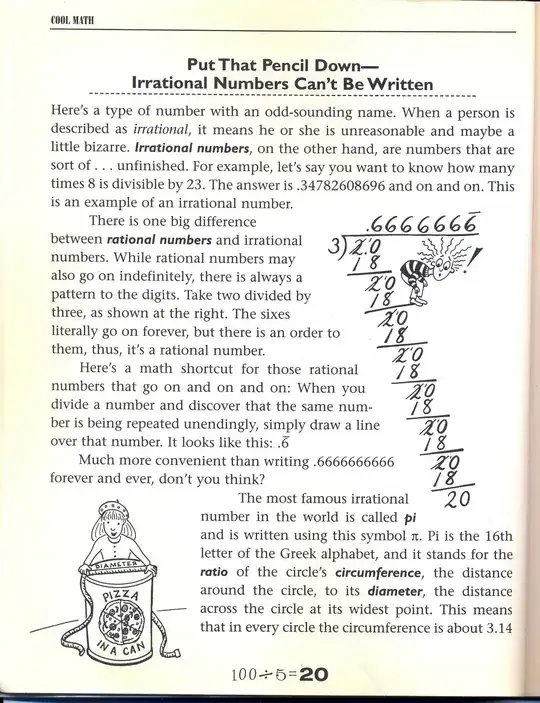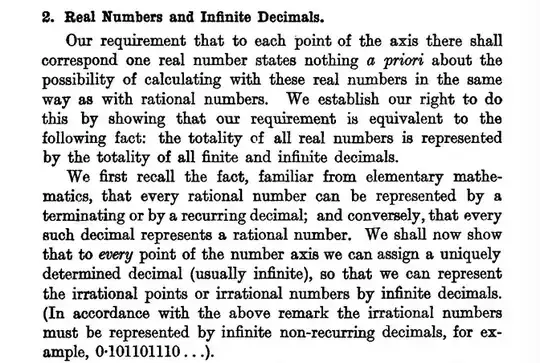A mathematical object is especially amenable to understanding when one can approach it in a 'geometrically symmetric' way, where you can 'get your hands around it', and when there is high correlation with intuition.
With the real numbers you want to also see, as 'plain as day', how the arithmetical operations work. Most will find that trying to 'pound this out' by representing numbers as decimal expansions that 'can keep on going' doesn't fit the bill.
It is possible to theoretically synthesize three constructions of real numbers: that of Stevin, Dedekind and Bachmann; see
$\quad$ THE REAL NUMBERS - A SURVEY OF CONSTRUCTIONS \ ITTAY WEISS
for a discussion of these techniques.
The theoretical pieces:
$\quad$ Stevin: Finite decimal display on an ideal calculator / ticks marks on a ruler -
$\quad$$\quad$$\quad$$\quad$ working with real numbers 'is as easy as' working with finite exapansions
$\quad$ Dedekind: Technical/precise specification of real number objects;
$\quad$$\quad$$\quad$$\quad\quad\;$ dovestails with set theory
$\quad$ Bachmann: Algorithic/calculating machine; intuitive/visual
To get this to work out, you have use a symmetric definition of a Dedekind cut. When you do this, you can bring in Bachmann's idea to 'squeeze down'. You also have to enjoy completing an ordered ring structure (the finite expansions) via cuts and then discover the rational numbers as a byproduct.
In this theory you can hand off the definition of addition/multiplication to the Bachmann squeeze technique. In the usual theory we learn the direct set definition for adding/multiplying cuts but that is just another theoretical route.
Finally, the theory works with any base - there is nothing special about $ten$ and we can also 'get there' using, say, binary fractions.
Let the ring of all the finite $b \ge 2\text{-ary}$ expansions be represented by $\mathcal B$ and the completion via Dedekind symmetric cuts be given by $\Bbb R$.
The first thing that happens with this theory is the 'trailing stuff is all $b-1$' can't happen. Any Dedekinkd cut can be viewed, by Bachmann, as left/right finite expansions that
(symmetrically ~ strict/two-sided clamp-down) spit out each $b \ge 2\text{-ary}$ fractional position to the right of 'the period' for that number.
Also in this theory you can show that every $x \ne 0$ in $\Bbb R$ has a multiplicative inverse. So, in particular, $n^{-1} \in \Bbb R$ for all integers $n \ge 2$.
Now we are not going to write out the details of this theory. In fact, we don't even define a symmetric cut. But, to get feel for it, we'll show the argument as to why any $S \subset \Bbb R$ that is bounded above must have a least upper bound.
If $S$ has a maximal element there is nothing to prove, so we assume it doesn't have one.
Let $T$ be the set of all upper bounds for $S$. If $T$ has a minimal element there is nothing to prove.
By proceeding from here (no max in $S$ or min in $T$) we will get a contradiction.
Let
$\quad S' = \{q \in \mathcal B \mid \text{ there exists a } s \in S \text{ such that } q \lt s\}$
$\quad T' = T \cap \mathcal B$
Argument: The order pair $(S', T')$ is a symmetric Dedekind cut and so $(S', T') \in \Bbb R$. Moreover, $(S', T')$ must be the the least upper bound of $S$. By our assumption $(S', T') \notin S$. But then it must be the minimal element of $T$, also a contradiction.
With this approach you do not, at the $\Bbb R$ start gate, have a definition of rational or irrational numbers. Perhaps a calculating robot knows the above and could care less about such subtleties. All it knows is that is can 'squeeze down' to any real number with as much precision as it required for the work at hand.

